
|
Sale 31
Pre-Long Beach Coin Auction
| Lot |
Photo |
Description |
Realized |
Lot 2291 |
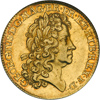 |
Great Britain. Guinea, 1714. George I. First Bust. S-3628. One-year type, very rare with the distinctive "PR EL" at the end of the king's titles in the reverse legend. In the following year, the letters "PR" were dropped (probably because the letters seemed crowded) and no longer did all the king's titles appear on his guinea. However, that is not the only nor even the most important distinctive feature of the Prince Elector guinea, because this single date also has the finest portrait of the first Hanover king, an elegant rendering with several ringlets of hair fully draped over the back of his neck and shoulder, in higher relief than any of his other guineas. It is a truly "stately" coin. But why was it chosen to be so distinctive? No single answer can exist, but it is highly probable that Parliament ordered the mint engravers to flatter the new king; as Prince Elector of Hanover, in his native Germany, he was far richer than any king of England had ever been. A special Act had been passed concerning the succession, as Anne died without heir; Parliament had chosen the Empress Sophia Dorothea, a descendant of James I, and she would have been Queen Sophia of England had she not also died; and so Georg Ludwig inherited the English Crown by default. He was a soldier and diplomat when he became King of England in September 1714, but his language and his manner were decidedly German. He disliked British politics and communicated with his ministers through advisors, preferring to devote his time to things cultural and pleasurable. He laid out Kensington Gardens in central London but mostly he idled away his time, hunting and playing cards, and eating; he died of a heart attack while vacationing back in Germany, leaving England to his son, who as George II made a successful transition to being an Englishman. NGC graded MS-63.
Estimated Value $7,500 - 9,000.
The Cheshire Collection.
View details and enlarged photos
| Realized
$7,475 |
Lot 2292 |
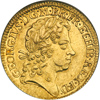 |
Great Britain. Guinea, 1719. S.3631; Fr-327; KM-546.1. George I. 4th bust. A choice piece, boldly struck and highly lustrous. Truly exceptional for this early style!. NGC graded MS-62.
Estimated Value $3,750 - 4,250.
The Cheshire Collection.
View details and enlarged photos
| Realized
$4,140 |
Lot 2293 |
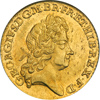 |
Great Britain. Guinea, 1726. S.3633; Fr-327; KM-559.1. George I. 5th bust. A lovely and lustrous guinea. NGC graded MS-63.
Estimated Value $4,500 - 5,500.
The Cheshire Collection.
View details and enlarged photos
| Realized
$3,795 |
Lot 2294 |
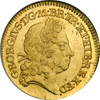 |
Great Britain. Half Guinea, 1717. S.3635; Fr-329; KM-541.1. George I. First bust. An interesting diebreak on the king's face as well as an adjustment line. Considerable original luster that creates exceptional eye-appeal. Rare type in grade. NGC graded MS-62.
Estimated Value $2,000 - 2,500.
View details and enlarged photos
| Unsold |
Lot 2295 |
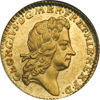 |
Great Britain. Half Guinea, 1725. S.3637; Fr-329; KM-560. George I, 2nd Bust. First year of this three year issue. A beautiful, lustrous coin with a bold strike and a clear portrait. NGC graded MS-63.
Estimated Value $2,750 - 3,250.
The Cheshire Collection.
View details and enlarged photos
| Realized
$2,645 |
Lot 2296 |
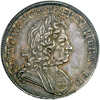 |
Great Britain. Silver Crown, 1718/6. George I. S-3639. Roses & Plumes in reverse angles. Edge not viewable in the slab but designated as ESC-111A, or "QUINTO" regnal year, by NGC. The crowns of this king are all very rare, almost never available better than VF grade, and truly elusive when as choice and eye-appealing as this specimen. Handsome, dark gray surfaces showing some golden iridescence. Light roller lines from the minting process can be seen in the center of the king's hair. The strike is evenly sharp, balanced, producing excellent detail in all design elements. It is so sharp, in fact, that the denticles of the obverse rim gleam with subtle luster and have a slope to them, as does a small steep hill. Perhaps most remarkable of all, there are essentially no marks on either side! Here and there, under a glass, tiny dots of die-rust and a few carbon alloy marks may be found, but this coin is literally immaculate. One of the finest known, extremely rare in this grade! NGC graded MS-62.
Estimated Value $6,500 - 7,000.
The Cheshire Collection.
View details and enlarged photos
| Realized
$9,775 |
Lot 2297 |
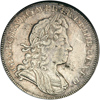 |
Great Britain. Halfcrown, 1720/17. George I. S-3642. Roses & Plumes reverse. Edge date not visible in the slab. All experienced British collectors know that the halfcrowns of this reign, the first George, the new Hanover monarch, are among the most difficult coins of the entire milled series to find in any decent condition. Old-time and most UK collectors will consider this coin "Good EF," and reasonably so, but what NGC sees is actual luster, not just shine as is so often confused with the real thing. A light-gray toning overlays the subdued mint gleam on this piece, but the luster is undeniable. The tops of the king's locks show some disturbance, a touch of wear, but it's fairly obvious from the condition of the fields that this coin never circulated although it was probably kept in somebody's leather purse, perhaps as a keepsake. There is one noticeable black carbon or "hay" mark just by the king's chin, and overall the obverse is quite pleasing. The reverse, however, just gleams with luster and is almost totally free from abrasion. The overdate is clear, making no mistake of what it is. In all, a truly exceptional example of this classic silver rarity! NGC graded MS-62.
Estimated Value $2,500 - 3,000.
The Cheshire Collection.
View details and enlarged photos
| Unsold |
Lot 2298 |
 |
Great Britain. Shilling, 1715. S.3645; ESC-1162. George I. First bust, Roses and plumes in angles. Light haymarking flakes on both sides. Otherwise gem quality with attractive silvery gray and light olive toning. Truly lustrous and choice! Also, first year of issue, and all of Georg Ludwig's silver is rare in such a well-preserved state. This was the high era of pirates in the Caribbean, and of postal spying in central Europe, of which the king's Hanover home was possibly the most important "vista" in the spy game. NGC graded MS-63.
Estimated Value $1,400 - 1,700.
The Cheshire Collection.
View details and enlarged photos
| Unsold |
Lot 2299 |
 |
Great Britain. Silver Shilling, 1718, Roses & Plumes. George I. S-3645. First laureate bust. A very "busy" design, the central reverse device now a square of radiant sun. On these first Georgian issues, the king's hair is engraved in relatively low relief, so that detail always shows but there is no crispness seen in some other portraits. Fairly rare type, not often seen above sort of an ordinary EF. This is among the best seen. A large die-break starts at 12 o'clock and runs down into the king's hair. Small black alloy flaws can be spotted, mostly hidden. The luster is diminished but definitely present, and it's clear this is an attractive Uncirculated coin, with handsome golden gray toning. In this year, 1718, the pirate Blackbeard was captured and executed in the Carolinas of colonial America, ending his reign of terror on shipping in the area. NGC graded MS-62.
Estimated Value $1,100 - 1,300.
The Cheshire Collection.
View details and enlarged photos
| Realized
$1,323 |
Lot 2300 |
 |
Great Britain. Shilling, 1722. S.3645; ESC-1174. George I. First bust, roses and plumes in angles. Sharply struck with attractive toning. This date cats £600 in EF, same as the others of its type, but the cataloguer cannot recall the last time he saw one! A rare coin in a very rare grade. NGC graded MS-63.
Estimated Value $1,250 - 1,500.
The Cheshire Collection.
View details and enlarged photos
| Realized
$1,020 |
Lot 2301 |
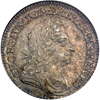 |
Great Britain. Shilling, 1720. S.3646; ESC-1168. George I. First bust, angles plain. Sharp strike with attractive deep toning. NGC graded MS-64.
Estimated Value $1,200 - 1,400.
The Cheshire Collection.
View details and enlarged photos
| Unsold |
Lot 2302 |
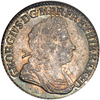 |
Great Britain. Silver Shilling, 1723 SSC. George I. S-3647. First laureate bust. Nice clean dies, producing a pleasing coin that does not have the usually seen soft strike (caused by grease) and consequent missing letters or soft digits in the date. A lovely and Choice Uncirculated piece, with gleaming luster under soft golden gray toning. Sharp details. Struck from clashed dies. A delightful example of this unique issue, made from silver taken from the South Seas Company, one of the world's earliest examples of a stock-market bubble rife with scandal and fraud; the WorldCom and Enron of the early 18th century. NGC graded MS-64.
Estimated Value $550 - 650.
The Cheshire Collection.
View details and enlarged photos
| Realized
$518 |
Lot 2303 |
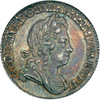 |
Great Britain. Sixpence, 1717. S.3651; ESC-1597; KM-553.1. George I. Roses and plumes in angles. Fully lustrous with lovely old toning. NGC graded MS-63.
Estimated Value $1,000 - 1,250.
The Cheshire Collection.
View details and enlarged photos
| Unsold |
Lot 2304 |
|
Great Britain. Silver Pennies, 1720 and 1727. S.3657. George I. 1720 HIPEX reverse error. NGC graded Both pieces MS-63.
Estimated Value $250 - 300.
The Cheshire Collection.
View details
| Unsold |
Lot 2305 |
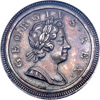 |
Great Britain. Proof silver Halfpenny, 1717. George I. Style of S-3659, the "Dump" issue (but Proofs not listed in Spink). Peck-771 (listed as "very rare"). 27 mm diameter. Inverted die alignment. The first two years of the new copper halfpenny coinage, 1717 and 1718, comprised the very first of the modern-style planchets, or flans, which provided a more uniform appearance. Mint master Isaac Newton had caused much delay in earlier attempts to bring forth a uniform copper coinage, seeking a high level of copper "purity" as he called it, than had previously been possible: coppers of earlier reigns had a variety of troubles and additions, from heavy black streaks to plugs meant to increase intrinsic value, but none had proven satisfactory as a circulating medium. Newton must have been proud of these new coins, which because they were on small, thick flans (which changed by 1719) have been called "dump issues" by generations of numismatists. A beauty of a coin! Bright silvery gray surfaces, with an incredibly bold impression of the dies (remember, this was made in 1717, more than 70 years before Boulton and Watt's steam-press coins). The outer circle on each side is deeply struck, each surrounded by a gigantic row of long denticles reaching to the coin's edge. Some reflectivity remains in the fields, producing a captivating eye-appeal! A major rarity in this condition, probably the finest known. NGC graded Proof 64.
Estimated Value $3,600 - 4,000.
The Cheshire Collection.
View details and enlarged photos
| Unsold |
Lot 2306 |
 |
Great Britain. Copper "Dump" Halfpenny, 1717. George I. S-3659. P-768. The famous first issue, the king facing right looking like a young "emperor." Stops on obverse. Coppers remained a tentative coinage for the Crown at this time in history, made to satisfy growing merchant needs but still regarded as less than regal in importance as they contained no "precious metal." As they were of low value, and fairly crude in manufacture compared to silver and gold coins, they also came under the spyglass of counterfeiters and within a few decades of when this coin was made counterfeiting of halfpennies would become a serious problem, ending when the government finally called upon the Soho Mint to produce newly styled and minted coppers that would defy copying. That would occur near the end of the reign of George III. At the beginning of the reign of the first George, however, when this coin was minted, coppers were crude things. Today's collectors find great charm in these pieces, and survivors are few that retain anywhere near the original look or amount of metal or sharpness of the design as it was intended to be seen. The Cheshire collector feels that this piece was specially struck, could have been a presentation piece kept aside for mint inspection; he thinks it is the finest extant non-Proof 1717 halfpenny. It enjoys an exceptionally sharp strike and a "balanced" look, nicely centered with good rims. Lovely dark-chocolate surfaces with glossy brown luster. Classic, bifurcated letters in the legends. Evidence of the difficulty the Royal Mint had with copper blanks may be glimpsed along the left side of the reverse rim. Ex Nicholson (a famous assemblage of 18th-century halfpennies, recently disbursed), and an important coin. NGC graded MS-63 Brown.
Estimated Value $1,600 - 1,800.
The Cheshire Collection.
View details and enlarged photos
| Realized
$1,840 |
Lot 2307 |
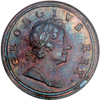 |
Great Britain. Halfpenny, 1718. S.3659; Peck-774. George I 'Dump' issue obverse. Considerable luster. Described by Spink in the early 1990's as having "considerable brilliance, full luster" and Colin Cooke comments that this coin is "almost certainly one of the finest in existence". Certainly, a finer example has not appeared in the marketplace during the last few decades. NGC graded MS-64 Red & Brown.
Estimated Value $1,850 - 2,250.
The Cheshire Collection.
View details and enlarged photos
| Realized
$2,013 |
Lot 2308 |
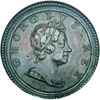 |
Great Britain. Copper Halfpenny, 1719. George I. S-3659, "Dump" issue. In reality, a sort of mule combining the 1717-type obverse with the second reverse on a larger flan of 27.8 mm diameter. Large denticles, as on the 1717 silver Proof. Peck-782 (called "excessively rare"), the so-called "obliquely grained" edge (which is just barely viewable in the slab, unfortunately). Gleaming chocolate-brown surfaces with virtually no marks, not even the smallest. A few flattish spots on each side, from an incomplete strike. The consignor states that he knows of only 2 of these experimental pieces, this one the finer in quality. An important coin. NGC graded MS-62 Brown.
Estimated Value $4,500 - 4,800.
The Cheshire Collection.
View details and enlarged photos
| Unsold |
Lot 2309 |
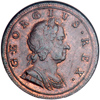 |
Great Britain. Halfpenny, 1719. S.3660; Peck-793. George I. Second obverse. With nearly full mint luster. A little weakness of striking on the King's hair- as often occurs, but overall a superbly well struck coin. Excessively rare, and all the more remarkable because obverse 2 is much rarer than obverse 1. NGC graded MS-64 Red & Brown.
Estimated Value $1,750 - 2,000.
The Cheshire Collection.
View details and enlarged photos
| Realized
$1,840 |
Lot 2310 |
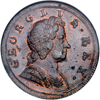 |
Great Britain. Halfpenny, 1721/0. S.3660; Peck-796. George I. This coin has considerable luster and mint red (that is not indicated by the grade assigned). The overdate is rare in any grade, but in this condition it is excessively rare. This is probably the finest known specimen. NGC graded MS-64 Brown.
Estimated Value $1,800 - 2,200.
The Cheshire Collection.
View details and enlarged photos
| Unsold |
Lot 2311 |
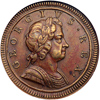 |
Great Britain. Brass Proof Halfpenny, 1722. George I. Second issue. Type of S-3660. Peck-801, listed as "Excessively Rare." The Spink price guide rather blithely lists each date and variety in this short series (1719-24) with a price in EF grade. However, what is not told there is that finding an EF of any date is a daunting task. As mentioned in our description of the Dump issue, these are crudely made coins, loaded with flaws ordinarily, and they went to wear fast being almost pure copper. Every date is rare in nice grade. However, among the varieties is a major rarity, a coin struck experimentally in brass (specific gravity 8.77, 85% copper and 15% zinc), not copper. This coin! It has a plain edge (not viewable in the slab) and obviously the preparation of the blank or flan was special. This coin does not have the cracks and flaws so much associated with the copper strikes. Obviously, the Royal Mint was seeking alternatives, several years into making these halfpennies for George I. One can only assume that brass was too expensive, and so it was dropped as an idea. What remains are the couple of known examples made of brass, one in the British Museum, this specimen, possibly another (although we believe the current lot is the only one in private hands). Light reddish brown toning but showing the brass color clearly. A spectacular, irreplaceable early 18th-century rarity, and both a landmark coin and one of the "copper stars" of the Cheshire Collection. NGC graded Proof 61.
Estimated Value $2,750 - 3,250.
The Cheshire Collection.
View details and enlarged photos
| Realized
$4,140 |
Lot 2312 |
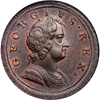 |
Great Britain. Copper Halfpenny, 1723. George I. S-3660. P-803. Second issue, same style as the famous "Dump" issue but the weight is distributed on a wider flan, or planchet, on this variety. The NGC grade sounds so clinical! This splendid coin is a Very Choice Uncirculated piece with glossy brown surfaces showing more than a hint of mint red luster around the letters of the legend on each side. The strike is also exceptional, and you can almost see the king's eyelashes! No planchet flaws on this beauty! However, there are some tiny rust marks (raised dots of copper) in the fields, and a tiny die-cut nick near the end of the king's nose. There are also some curious things to study: the "E" in the king's name is lacking the bottom left serif, as does the same letter in "REX," where the "X" is double-cut at the top. Reverse: the first "A" in "BRITANNIA" has a curious "comma" or V-wedge at its bottom, and the last digit of the date in the exergue is surrounded by tiny die-rust marks. All in all, a classic of its age in every respect! NGC graded MS-64 Brown.
Estimated Value $1,800 - 2,000.
The Cheshire Collection.
View details and enlarged photos
| Unsold |
Lot 2313 |
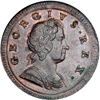 |
Great Britain. Halfpenny, 1724. S.3660; Peck-806. George I. Considerable luster with traces of red. The last year of the George I halfpenny, and practically impossible to obtain in this incredible grade. NGC graded MS-64 Brown.
Estimated Value $1,600 - 1,900.
The Cheshire Collection.
View details and enlarged photos
| Unsold |
Lot 2314 |
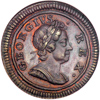 |
Great Britain. Farthing, 1719. S.3662. George I. Variety with large obverse letters. With luster. Very Rare. NGC graded MS-63 Brown.
Estimated Value $1,200 - 1,400.
The Cheshire Collection.
View details and enlarged photos
| Unsold |
Lot 2315 |
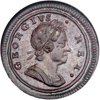 |
Great Britain. Farthing, 1721. S.3662. George I. Well struck with some luster. NGC graded MS-64 Brown.
Estimated Value $1,000 - 1,200.
The Cheshire Collection.
View details and enlarged photos
| Unsold |
|
|